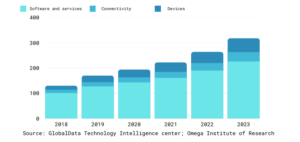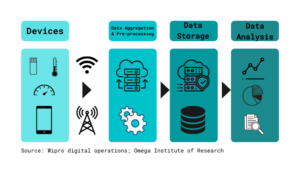- Industries
Industries
- Functions
Functions
- Insights
Insights
- Careers
Careers
- About Us
- Information Technology
- By Omega Team

The Internet of Things (IoT) is a network of interconnected, internet-connected objects that can gather and transmit data without the need for human interaction across a wireless network. The possibilities for personal or professional development are limitless. A connected medical device, a biochip transponder (think livestock), a solar panel, a connected automobile with sensors that alert the driver to a variety of issues (fuel, tire pressure, needed maintenance, and more), or any object equipped with sensors that can gather and transfer data over a network can all be considered a ‘thing.’
Businesses are currently inspired by IoT and the potential for increased revenue, lower operational costs, and improved efficiencies. Regulatory compliance is also a driving force for businesses. IoT device installations give the data and insights required to optimize workflows, visualize usage patterns, automate operations, meet compliance needs, and compete more effectively in a changing business environment, regardless of the reasons.
How do IoT devices work?
Smartphones, on the other hand, play a significant part in the IoT because many IoT devices can be controlled via a smartphone app. You can, for example, use your smartphone to interact with your smart thermostat to have the appropriate temperature waiting for you when you arrive home from work. Another benefit? This can help you save money on energy expenditures by eliminating unnecessary heating or cooling while you’re away. IoT devices have sensors and mini-computer processors that use machine learning to act on the data acquired by the sensors. IoT gadgets are essentially little computers that are connected to the internet and are susceptible to malware and hacking.
Machine learning is the process by which computers learn in the same manner that humans do — by collecting data from their environment and it is what allows IoT devices to become smart. This information can assist the machine in learning your preferences and adapting to them. Machine learning is a sort of artificial intelligence that allows computers to learn without the need for human programming. That doesn’t mean your smart speaker will join you in discussing the highlights of yesterday night’s big game. However, because you’re near a grocery store, your connected refrigerator may send you a notification on your smartphone indicating you’re low on eggs and milk.
Global IoT Market
The global market for Internet of Things (IoT) technology, which consists of software, services, connectivity, and devices, reached $130bn in 2018.
Figure 1: Global Data Technology Intelligence Center

“This industry is extremely competitive because of the diverse network of vendors selling software and services,” says Kathryn Weldon, GlobalData’s Technology Analyst. Operators are competing to provide value-added services in addition to connectivity, while network and infrastructure providers are expanding into IoT platforms and applications. IoT application development and ‘pre-shrunk applications are provided by IT Service Providers, systems integrators, and consultants, while business software vendors and vertical VARs and experts provide IoT application development and ‘pre-shrunk applications.
IoT in Healthcare Industry
Remote monitoring in the healthcare industry is now possible thanks to the Internet of Things (IoT)-enabled gadgets, which can keep patients safe and healthy while also empowering clinicians to provide superior treatment. As contacts with doctors have gotten easier and more efficient, it has also boosted patient participation and satisfaction. Furthermore, remote monitoring of a patient’s health helps to shorten hospital stays and avoid re-admissions. IoT has a big impact on lowering healthcare expenses and increasing treatment outcomes.
IoT for Patients
Patients have access to individualized attention through wearable gadgets such as fitness bands and other wirelessly connected equipment such as blood pressure and heart rate monitoring cuffs, glucometers, and so on. These gadgets may be programmed to remind you of things like calorie counting, exercise, appointments, blood pressure changes, and much more. IoT has altered people’s lives, especially the lives of elderly patients, by allowing them to track their health problems in real-time. This has a significant influence on single people and their families. An alarm mechanism delivers signals to family members and worried health providers if a person’s usual activities are disrupted or changed.
IoT for Physicians
Physicians can keep a better check of their patients’ health by employing wearables and other IoT-enabled home monitoring equipment. They can keep track of whether or not patients are sticking to their treatment programs, as well as whether or not they require immediate medical assistance. IoT allows healthcare providers to be more vigilant and proactive in their interactions with patients. Data from IoT devices can assist clinicians in determining the optimal treatment method for their patients and achieving the desired outcomes.
IoT for Hospitals
Apart from monitoring patients’ health, hospitals can benefit from IoT devices in a variety of ways. Medical equipment such as wheelchairs, defibrillators, nebulizers, oxygen pumps, and other monitoring equipment are tracked in real-time using IoT devices with sensors. Medical personnel deployment at various places can also be analyzed in real-time. Infection propagation is a big problem among hospital patients. IoT-enabled hygiene monitoring devices aid in the prevention of infection in patients. Asset management, such as pharmacy inventory control, and environmental monitoring, such as checking refrigerator temperature, is also aided by IoT devices.
IoT for Health Insurance Companies
With IoT-connected intelligent devices, health insurers have several options. Data collected by health monitoring devices can be used by insurance firms for underwriting and claims processing. They will be able to detect fraud claims and discover underwriting prospects using this information. In the underwriting, pricing, claims management, and risk assessment procedures, IoT devices provide transparency between insurers and customers. Customers will have appropriate visibility into the underlying logic behind every decision taken and process outcomes as a result of IoT-captured data-driven decisions in all operating processes.
Figure 2: Wipro Digital Operations

Advantages of IoT in the Healthcare Industry
Cost savings: IoT allows for real-time patient monitoring, reducing the number of unnecessary doctor visits, hospital stays, and re-admissions.
Improved Treatment: It allows clinicians to make informed judgments based on data and provides complete openness.
Faster Disease Diagnosis: Using continuous patient monitoring and real-time data, doctors can diagnose diseases at an early stage, even before symptoms appear.
Providing Proactive Medical Care: Continuous health monitoring allows for the provision of proactive medical treatment.
Drugs and Equipment Management: In the healthcare industry, managing pharmaceuticals and medical equipment is a huge concern. These are efficiently handled and utilized by connected devices, resulting in lower expenses.
Error Reduction: Data collected by IoT devices not only aids in better decision-making, but also ensures that healthcare operations run smoothly with fewer errors, waste, and system expenses.
Smart Homes using IoT devices
When your home contains a variety of smart devices that you can operate remotely and program to automate house upkeep, you can call it smart. They can also be linked together to form a single network. For example, the lights may switch on as soon as you enter the house (sensors will detect this), or your vacuum cleaner may begin cleaning at 11 a.m. every day.
But it’s when IoT (Internet of Things) joins this group that the genuine magic begins. It connects all of the devices to the internet, expanding the possibilities of a home network. For example, you can now use your smartphone or computer to monitor what is going on in your home via security cameras. IoT applications enable you to connect devices and have them communicate without your intervention. Consider this scenario: as soon as your automobile pulls away from the workplace parking lot, your air conditioner begins to chill your home, allowing you to return home to a comfortable environment after a hot day.
Benefits of IoT Smart Homes
Monitoring and Control: The Internet of Things vastly improves your ability to control and monitor all of the operations that occur in your house. The fridge may send you an alert if your yogurt goes bad in two days or add milk to your shopping list. Every day, the IoT application gathers data about how your household operates, processes it, and displays the most important findings to you.
Energy and Cost Savings: With thorough statistics on each smart device’s work and energy consumption, you can simply optimize their use and alter your smart home settings to save money. You can also delegate all of your smart home system’s functions to it. If no one is home, the system will turn off any gadgets that are not in use and reduce power consumption.
Impact on the Environment: Energy savings help to decrease a negative influence on the environment and live a “greener” life, in addition to lowering your bills.
Improved Security: Because it gives you complete control over everything inside and outside your home, a smart home security system is an excellent tool for securing your property. Motion, smoke, and other sensors, as well as security cameras and smart locks, all work together to alert you if something goes wrong. You can monitor what’s happening inside and around your home from your office or while resting on a beach halfway around the world.
Conclusion
The Internet of Things (IoT) has the potential to drastically improve information availability and is expected to alter businesses and organizations in practically every industry around the world. As a result, most technology businesses’ strategic objectives, regardless of their industry emphasis, are anticipated to include discovering ways to utilize the power of the IoT. The large number of various technologies required to support IoT adoption and growth sets a premium on interoperability, leading to broad attempts to define standards and technical specifications that enable seamless communication between IoT devices and components.
Subscribe
Select topics and stay current with our latest insights
- Functions